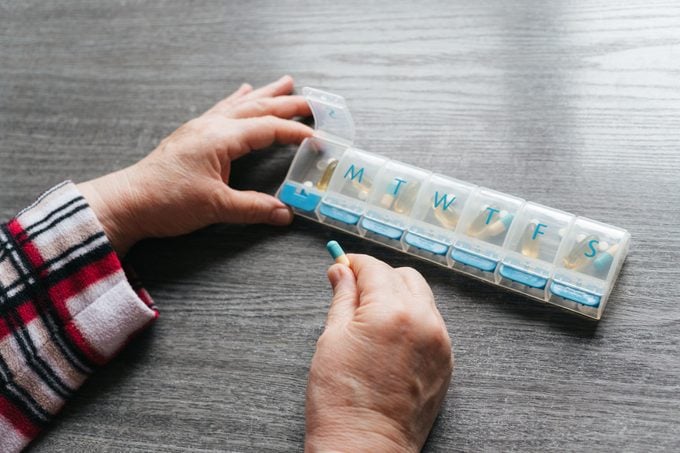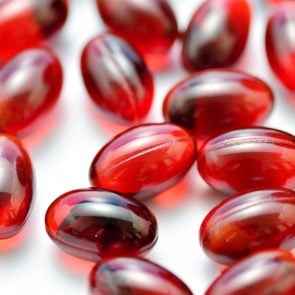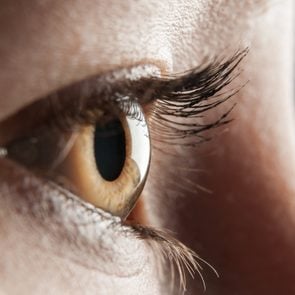6 Vitamins (and Minerals) That May Help Macular Degeneration
Updated: May 08, 2023
Medical doctors say supplementing with vitamins and minerals may help save your sight if you have macular degeneration.
Macular degeneration vitamins and minerals
Macular degeneration is a disease that can lead to blindness. While there are no good medical treatments for the most common form of the disease (called “dry macular degeneration”), a simple regimen of vitamins and minerals may help forestall vision loss.
“Research shows that combination of vitamins all taken together over five years reduced vision loss about 25%,” says Jacque Duncan, MD, a professor of clinical ophthalmology and academic director of the Retina Service at the University of California San Francisco.
Learn about how vitamins and minerals can protect your vision if you have age-related macular degeneration (AMD).
What is age-related macular degeneration?
The condition develops when yellowish waste materials from the eye, called drusen, build up under the central (macular) part of the retina, explains Abdhish R. Bhavsar, MD, a clinical spokesperson for the American Academy of Ophthalmology (AAO).
“No one knows what causes AMD, and there are many factors that can increase your risk,” explains Luciano V. Del Priore, MD, PhD, chair of the Department of Ophthalmology & Visual Science, Yale Medicine. “None of us can modify our genetics (after all, we are related to whoever we are related to), but there are numerous modifiable risk factors, including a healthy diet low in fats and high in leafy green vegetables, exercise, and good blood pressure control.”
“The older you are, the more likely you are to get it,” says Emily Y. Chew, MD, the director of the division of epidemiology and clinical applications at the National Eye Institute (NEI). “If you have a family history of it, that also puts you at higher risk of getting it,” adds Brian Boxer Wachler, MD, ophthalmologist and medical reviewer at All About Vision.
Two forms of AMD
This leads to two major forms of macular degeneration, the most common being dry AMD. This affects about 80% of people who have AMD, according to the AAO.
With wet AMD, extra blood vessels develop under the retina. If they leak, they can scar the macula and impair vision. “That loss of vision can be fairly quick and abrupt in some patients,” Dr. Bhavsar says.
In fact, he notes, though it represents the minority of AMD cases, wet AMD is responsible for the vast majority of severe vision loss from the disease.
10 Foods That Slash Your Risk of Macular Degeneration
Symptoms of macular degeneration
In the beginning and intermediate stages, AMD often has no symptoms. “You could have 20/20 vision yet still have AMD,” Dr. Chew says.
As the disease progresses, some people report problems seeing in the dark and transitioning from light environments to dark environments. Vision can also become blurry and distorted or wavy.
Wet AMD involves sudden, severe, and dangerous eye symptoms, including pain and nausea.
Vitamins and minerals for AMD
There’s no one vitamin or mineral that helps slow the progression of AMD. Instead, it’s a specific combination called AREDS2, named after the Age-Related Eye Disease Study, which demonstrated their potential benefit. AREDS2 consists of high doses of:
- vitamin C (ascorbic acid) 500 milligrams (mg). “Vitamin C is a powerful antioxidant that may help protect the eyes from oxidative stress and inflammation. A study published in the Journal of Nutrition found that higher dietary intake of vitamin C was associated with a lower risk of developing AMD,” explains Crystal Scott, MS, RD, LD, CDCES, CSP, CSSD, registered dietitian at Top Nutrition Coaching.
- vitamin E 400 international units (IU). “Like vitamin C, vitamin E is an antioxidant that may help protect the eyes from damage,” Scott says, “and taking a daily supplement containing vitamin E reduced the risk of progression to advanced AMD by 25%.”
- lutein 10 mg. “Lutein is a carotenoid that is found in high levels in the macula,” Scott says. “Studies have shown that higher dietary intake of lutein may be associated with a lower risk of AMD.”
- zeaxanthin 2 mg. “Zeaxanthin is another carotenoid that is found in high levels in the macula. Like lutein, it may help protect the eyes from oxidative stress and inflammation,” Scott says.
- zinc (as zinc oxide) 80 mg. “Zinc is a mineral that plays a role in immune function and wound healing,” Scott says. “The first Age-Related Eye Disease Study (AREDS) formula included high levels of zinc.”
- copper (as cupric oxide) 2 mg. “Copper is a mineral that is important for the formation of connective tissue in the eye,” Scott says. “It is included in the AREDS formula to balance the high levels of zinc, which can reduce copper levels in the body.”
They are available as over-the-counter pills and are usually taken twice a day. “Nutritional supplements have only been proven to be helpful for patients with high risk disease, and are of unproven benefit in patients with no or mild disease,” Dr. Del Priore says.
“A diet that is high in lutein and zeaxanthin, which you can find in foods such as orange peppers, broccoli and green leafy vegetables, has been shown to lower the risk of developing AMD,” says certified nutritionist Serena Poon, CN, CHC, CHN.

The first AREDS formula
Before AREDS2, the NEA tested the effectiveness of a slightly different AREDS formula, now known as AREDS1.
Unlike AREDS2, AREDS1 also contained beta-carotene. But the beta-carotene corresponded with an increased risk of lung cancer in smokers, Dr. Duncan says. (Smoking is also a major risk factor for AMD, Dr. Bhavsar notes.)
For AREDS2, researchers left out the beta-carotene and added the lutein and zeaxanthin. “This is the version most commonly used today,” Dr. Del Priore says.
8 Vitamin Secrets Doctors Tell Their Friends
What do the vitamins and minerals do?
Vitamins C and E, zinc, lutein, and zeaxanthin are antioxidants, meaning they protect your cells from damage. “Oxidative stress is a major factor in developing AMD, so dietary antioxidants are exceedingly important when considering treatment of this condition,” Poon says.
“There has been a lot of research showing how those vitamins slow down oxidative damage in the eye and retina,” Dr. Bhavsar says. “That’s how they were picked.”
Dr. Boxer Wachler says that in a separate study, omega-3 fatty acids including fish oil reduced the risk of wet AMD.
“The potential benefits of individual components is not known,” Dr. Del Priore explains, “But the combination may have the most effect.”
“Together they protect the retina in a certain way,” says Dr. Bhavsar, who is also director of the Retina Center in Minneapolis. In a separate study, omega-3 fatty acids including fish oil reduced the risk of wet AMD.
Who benefits from AREDS?
AREDS2 doesn’t seem to prevent AMD from developing in the first place, Dr. Chew says. That suggests the supplement won’t help if you already have drusen.
It also may not help if you have early AMD. In that case, your doctor should be monitoring you with dilated eye exams at least once a year to catch any deterioration in the condition. The same holds if you already have advanced AMD.
But AREDS2 can slow the progression of intermediate dry or wet AMD in both eyes, or those with advanced disease in just one eye, according to the NEI.
Risks and side effects
“We have very extensive data and very extensive reviews of the data, and it looks like [AREDS2] is a very safe ‘medicine’ to take,” Dr. Bhavsar says.
Although you can get the supplement over the counter, you shouldn’t be taking it unless your doctor has diagnosed AMD and recommended it.
You should always consult your healthcare provider before taking any supplements, as they can have side effects and interact with other medications. Instead of any risk from supplements, Poon recommends a healthy diet. “These nutrients can also be absorbed through a healthy diet that is rich in vegetables, fruits and whole grains. Shifts in diet and lifestyle can be a first step for someone who is looking to preemptively protect their eye health and whose doctor has not prescribed this specific high-dose series of supplements,” Poon says.
13 Supplement or Medication Combos You Should Never Mix
How to buy AREDS2
The pills are available in most pharmacies, Dr. Duncan says, but that doesn’t mean you should buy the first one you see. There are many different brands, so always check the label to make sure it says “AREDS,” and check the ingredient list to make sure all the components are there.
It’s a good idea to be vigilant when you’re buying supplements in general, because they do not always contain what they say they contain. Even better, ask your doctor for a recommendation.
Other treatments
“The FDA recently approved Synfovre, a drug for the geographic atrophy which is the most advanced form of AMD,” Dr. Del Priore says, “And treatments are also available for wet AMD in the form of anti-VEGF drugs, which hinder the development of those extra blood vessels by controlling a protein known as vascular endothelial growth factor (VEGF). One example is Avastin, a drug for treating colorectal, lung, and other types of cancer.
Others are specifically for AMD, Dr. Bhavsar says.
Meanwhile, Dr. Duncan says, clinical trials are underway to find new treatments for both types of AMD and to see if existing drugs, like metformin (for diabetes), could be useful.
Detecting AMD
In order to know if you have AMD, you need to get your eyes checked regularly. The AAO recommends eye exams for all adults over the age of 40, and earlier if you have risk factors like smoking or a family history.
“That’s the age at which some of these conditions start becoming more prevalent—not just AMD, but cataracts and glaucoma start increasing,” Dr. Bhavsar says.
At home, use an Amsler grid every day to pick up early changes in vision. This is just a simple grid (straight horizontal and vertical lines) with a dot in the middle.
Cover one eye and use the other to look at the center dot at a distance of about 12 to 15 inches from your face. If any areas look darker or blank or are distorted (wavy or blurry), see an eye doctor. Repeat the procedure with the other eye.
Preventing AMD
A healthy lifestyle can not only help slow the progression of AMD, but may help prevent it.
“The heart-healthy Mediterranean diet reduces progression 40% in some cases,” Dr. Chew says.
Pay particular attention to dark leafy greens like kale and spinach, colorful foods (they have antioxidants), and fatty fish like salmon, which are some of the best foods to improve your eyesight.
Exercise and UV-blocking sunglasses can also help, Dr. Bhavsar says. “Wear sunglasses even on cloudy days,” Dr. Boxer Wachler advises.
- I Had Probiotic Soda Every Day for a Week—Here’s What Happened
- The 12 Best Commuter Bikes in 2023
- Do You Have an Under-active Thyroid? This 90-Second Quiz Helps You Find Out
- Why Your Eyes Could Be Key to Early Alzheimer’s Diagnosis
Additional writing and reporting by Jaime Stathis.



















